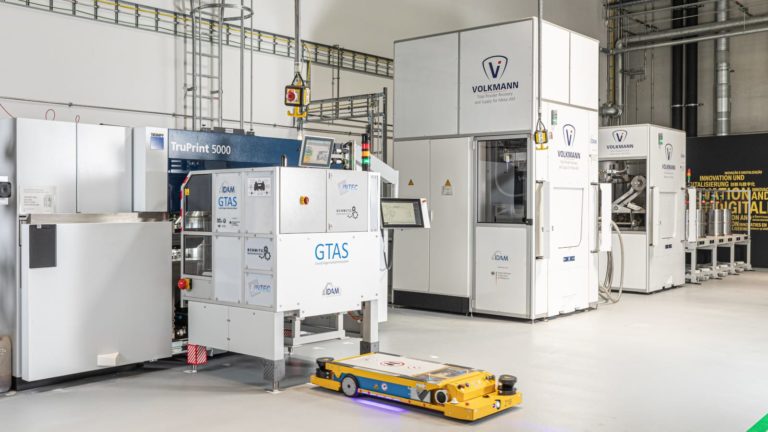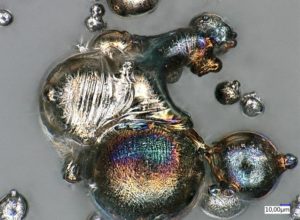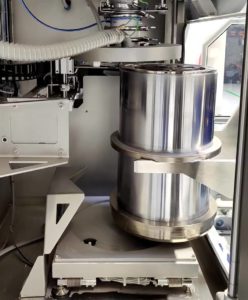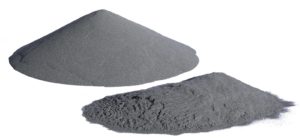Metal powder for 3D printing is expensive, and a large amount of powder is left unused during a print job. Before reuse, however, the fused powder agglomerates must first be separated out. As part of the IDAM research project 1), VOLKMANN has developed a powder recycling station for this purpose and integrated it into a fully automated 3D printing, unpacking, and powder recycling process at BMW AG.

Industrial 3D printing with metal powders also produces – in addition to the desired components – many small agglomerates of fused powder particles. Broken support structures can also be found in the used powder. Such particle agglomerates and foreign bodies must be reliably removed before the powder is fed back into a printing process.

The recycled powder is usually mixed with virgin powder. The amount of new powder compensates for the amount that was previously processed in the printed components. The mixing ratio of virgin to recycled powder can affect component quality, which is why product development and quality assurance often impose tight specifications. In addition, homogeneous mixing must be ensured.
The IDAM project (Industrialization and Digitalization of Additive Manufacturing) was funded by the German Federal Ministry of Education and Research (BMBF). The IDAM research project demonstrator line is a digitally networked, fully automated 3D printing production line for automotive series production. Under the leadership of the BMW Group, a total of 12 companies and research institutes participated in the project from 2019 to 2022 including VOLKMANN GmbH. Successful practical trials were carried out with one demonstration line at BMW AG (Munich, Germany) and at a second line at GKN Additive (Bonn, Germany). The preparation of used metal powder and mixing with virgin powder was handled in the demonstrator line at BMW AG by a central powder recycling station. At GKN, powder recycling was carried out by a PowTReX system from VOLKMANN.
The central powder recycling station at BMW was developed and built by VOLKMANN, incorporating valuable operating experience from the PowTReX powder recycling system. In addition, the station offers capacity for separately buffering both used and virgin powder, as well as for mixing these metal powders in a user-specified ratio. The station also handles the drying of the metal powder – more on that later.
The very high degree of automation of the IDAM demonstrator line is also found in the powder recycling station. The used metal powder is pneumatically transferred from the upstream VOLKMANN depowdering station by vacuum conveying through a pipe to the powder preparation station where it is buffered in a hopper. Also within the station, all process steps for the preparation incl. the mixing with virgin metal powder run automatically.

The finished metal powder is filled into a supply cylinder, sealed with a lid, automatically loaded onto and transported by a transfer module (GTAS / AGV) to the next station.

Only filling with virgin powder is still done manually in this prototype plant. New powder is removed via vacuum out of wide-necked bottles by a suction lance and transported to the storage container by a vacuum conveyor. In future production lines, this work step can also be automated.
The high degree of automation in the powder preparation station protects operating personnel from direct exposure to metal powders and dusts. Manual work steps with full PPE are largely eliminated. Powder preparation takes place in sealed containers, and powder conveying in negative pressure prevents the escape of dusts.
Higher component quality due to dried metal powder
The VOLKMANN powder recycling station can do even more – it also dries the metal powder. In the IDAM research project, however, drying was not planned in the beginning. Instead, the metal powder was to be protected from oxidation with an inert gas. However, subsequent investigations by the Fraunhofer-ILT (Institute for Laser Technology, Aachen, Germany, https://www.ilt.fraunhofer.de/en.html) showed that the use of inert gas when handling metal powder does not lead to any significant improvement in component quality.
At the same time, it was proven that moisture in the metal powder has a considerable influence on the printing result. Wet metal powder has poor flow properties, and therefore imperfections can occur in the powder bed when a new layer of powder is applied. With some metals and alloys – e.g. aluminum – the bound water also creates pores in the component during printing.

The cause of metal powder moisture lies in the often highly hydrophilic surfaces of metals. The fine metal powder has a large surface area and can therefore adsorb a large amount of water from the environment. It takes only a few minutes of exposure for the metal powder to adsorb enough water vapor from the air or other gas atmosphere to impact the print result. Even when using inert gases such as nitrogen, it should be noted that some gas supplies have too high a moisture content which can still compromise the metal powder quality.
Studies have also shown that drying can restore the original properties of the metal powder. Vacuum drying is particularly well suited for this purpose: it can be implemented very easily in a space-saving manner and is very efficient. In addition, this technology does not require a heat source which is a great advantage with regard to the potentially explosive metal dusts. A constant low residual moisture content can be achieved even with large variations in the original moisture content of the supplied powder. Vacuum drying can also be used for virgin metal powder to remove any moisture that may have been absorbed in the logistics chain.
Vacuum drying can readily be combined with a vacuum conveying system. In the BMW demonstrator line, vacuum drying was integrated into the central powder preparation station, with the drying process taking place after screening and mixing with virgin powder.
There is considerable savings potential by eliminating the use of inert gas in powder handling – both in technical equipment and in operating costs. Vacuum drying can be implemented more cost-effectively than a system using inert gas and the associated inert gas handling equipment. In the case of the powder preparation plant at BMW, approx. 30 % of the originally budgeted investment costs were saved by using vacuum drying.
Central powder preparation for multiple 3D printers
The powder recycling station has enough capacity to handle powder preparation requirements for four or more 3D printers. This can also be combined with an automatic depowdering station, creating a very economical solution for the automatic unpacking and depowdering of build jobs and the subsequent powder preparation.
In the near term, transporting the build frames and powder containers between the 3D printers and a central depowdering and powder recycling station can be done manually by pallet handling equipment. In the future, fully automated guided vehicles (AGVs), and automatic distribution of metal powder to the 3D printers by vacuum conveying through a piping network will become more common in additive manufacturing.
¹ Further news about the IDAM project: